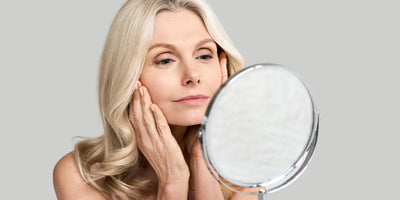
Astaxanthin: Enhancing Sun Protection from Within
Unveiling the Power of Astaxanthin for Sun Protection
Astaxanthin, a naturally occurring carotenoid found in various marine organisms such as algae, salmon, and shrimp, has garnered significant attention in recent years. This potent antioxidant's potential extends beyond its role in imparting vibrant color to the organisms that contain it. One of the promising applications of astaxanthin lies in the realm of skin health, particularly as a natural protection against sun damage. This article delves into the science behind astaxanthin’s sun protection benefits and explores how this nutrient may be incorporated into a comprehensive sun protection routine.
The Role of Astaxanthin in Sun Care
Astaxanthin is not a standalone solution to sun protection. Despite its potential benefits, it should be considered as part of a broader, comprehensive strategy for sun care. Sun protection involves more than shielding the skin from UV rays; it also requires maintaining the skin's health and integrity. This includes proper hydration, nutrient intake, and avoidance of overexposure to the sun, all of which are essential to reducing the risk of skin damage and premature aging.
Understanding Astaxanthin: The Internal Sunscreen
Astaxanthin has commonly been referred to as an internal sunscreen, or sunscreen in a pill. It has earned this reputation by prolonging the time it takes for your skin to burn in direct sunlight. To understand how astaxanthin can do this, we need to first understand what Astaxanthin is.
The Source of Astaxanthin: From Algae to Marine Life
When a specific type of algae strain called haematococcus pluvialis is put under stress, it excretes a pigment called astaxanthin to protect itself. This red pigment acts like a forcefield around the algae, protecting it from environmental stresses such as a change in water temperature or exposure to direct UV light from the sun. This algae is responsible for the red colour of salmon, lobster, flamingos, crabs and other such marine life.
The Power of Astaxanthin: An Antioxidant Shield
When breaking down astaxanthin to understand how it works, researchers found it has incredible antioxidant properties which explains its ability to protect the skin from the sun. Antioxidants work to mop up free radicals, which are unstable molecules without a paired electron that can cause cell damage and inflammation.
Sunburn is a perfect example of inflammation you can see. Redness, pain or discomfort, and warmth to the touch are all typical signs of inflammation. The UV rays from the sun over time will damage skin cells and cause sunburn.
Scientific Evidence: Astaxanthin and Sun Protection
Further scientific study of astaxanthin in human, animal, and cellular models has demonstrated it enhances sun protection and reduces UV damage that causes skin to burn and age. Subjects taking astaxanthin showed an increased time to redness under exposure to UV light compared with the placebo. The astaxanthin group also had less loss of skin moisture in the area exposed to the light.
Astaxanthin: A Complementary Strategy for Sun Protection
Taking astaxanthin could be a great option for those with sensitive skin that burns within a few minutes or those that spend significant amounts of time outside, working or playing sports, and can’t be applying sunscreen constantly. However, if you know you’ll be spending an extended period in harsh sunlight, sunscreen is still recommended. Remember, astaxanthin should be viewed as a complementary strategy for sun protection rather than a replacement for traditional methods.
A Natural Sunscreen from Within
Astaxanthin is part of a family of nutrients known as carotenoids, which are responsible for the red, orange, and yellow pigments found in various fruits and vegetables. Besides its coloring properties, astaxanthin is also a powerful antioxidant, capable of neutralizing harmful free radicals generated by UV exposure and other environmental stressors.
This antioxidant property positions astaxanthin uniquely in the fight against sun damage. Unlike topical sunscreens that create a physical barrier on the skin surface, astaxanthin operates from within the body, helping to mitigate the harmful effects of UV rays from the inside out. When consumed, astaxanthin is incorporated into skin cell membranes and provides a form of internal sun protection, reducing the damage that occurs when skin cells are exposed to UV light.
However, the effect of astaxanthin is not immediate and requires consistent intake over time to build up in the skin. As a fat-soluble carotenoid, astaxanthin is stored in fatty tissues and slowly released, meaning that it may take several weeks of regular consumption to notice any sun protection benefits.
The Science Behind Astaxanthin's UV Protection Benefits
At a molecular level, astaxanthin works by quenching reactive oxygen species (ROS), the harmful byproducts of UV exposure. ROS can cause oxidative damage to DNA, proteins, and lipids within cells, leading to inflammation, premature skin aging, and an increased risk of skin cancer. As a potent antioxidant, astaxanthin neutralizes ROS, preventing this oxidative damage.
Several studies support astaxanthin's protective role against UV-induced skin damage. For instance, a 2012 study published in Experimental Dermatology demonstrated that dietary supplementation with astaxanthin could reduce the skin's inflammatory response to UV radiation, including sunburn and DNA damage.
Astaxanthin's UV protective properties are also complemented by its ability to reduce inflammation and enhance the skin's natural defense mechanisms. This combined approach – addressing both the immediate and long-term effects of sun exposure – makes astaxanthin a unique and potent addition to sun protection strategies.
Shielding Against Harmful UV Rays: Astaxanthin's Photoprotective Effects
Astaxanthin has shown photoprotective effects, safeguarding the skin from the harmful effects of UV radiation. When skin cells are exposed to UV rays, a cascade of damaging events takes place, including DNA mutation, collagen degradation, and cellular inflammation – all of which contribute to skin damage and premature aging.
Astaxanthin, through its potent antioxidant and anti-inflammatory properties, can disrupt this cascade at several stages. By scavenging ROS, it minimizes DNA damage and oxidative stress. Moreover, its anti-inflammatory properties can limit the cellular inflammation caused by UV exposure.
However, astaxanthin's photoprotective effects shouldn't be viewed as an alternative to topical sunscreens. While it provides an additional layer of protection, it does not completely block the harmful UV radiation from reaching the skin. Thus, combining astaxanthin supplementation with a broad-spectrum sunscreen that shields the skin from both UVA and UVB rays is critical for optimal sun protection.
Reducing Sunburn and Skin Damage: Astaxanthin's Role
Astaxanthin also plays a critical role in reducing sunburn and skin damage, hallmarks of acute UV exposure. Sunburn is the skin's inflammatory response to excessive UV radiation, characterized by redness, pain, and sometimes blisters. On a cellular level, this involves the production of pro-inflammatory molecules and the influx of immune cells to the affected area.
As a powerful anti-inflammatory agent, astaxanthin can modulate this inflammatory response, reducing redness and pain associated with sunburn. Furthermore, by mitigating DNA damage caused by UV radiation, it may also reduce the risk of long-term skin damage, such as hyperpigmentation and skin cancer.
Again, astaxanthin's role in reducing sunburn is an addition, not a replacement, to traditional sunburn prevention methods. Wearing protective clothing, limiting sun exposure during peak hours, and applying sunscreen are still essential steps for preventing sunburn and subsequent skin damage.
Enhancing Skin Elasticity and Moisture Retention with Astaxanthin
Astaxanthin's benefits extend beyond sun protection. This powerful antioxidant has also been linked to improved skin elasticity and moisture retention, two factors critical for maintaining healthy, youthful skin. The sun's UV rays can degrade collagen and elastin – proteins that give skin its firmness and elasticity – leading to wrinkles and sagging skin.
Astaxanthin can help protect these vital proteins from UV-induced damage, maintaining skin elasticity and firmness. Moreover, studies have shown that astaxanthin can enhance the skin's barrier function, reducing water loss and maintaining skin hydration.
While astaxanthin's role in enhancing skin elasticity and moisture retention is promising, it's important to remember that healthy skin also relies on other factors such as proper hydration, a balanced diet, and regular exercise. Therefore, astaxanthin supplementation should be considered as part of a broader skin health strategy, not a standalone solution.
Astaxanthin's Antioxidant Power
Premature skin aging is a common consequence of chronic sun exposure. UV radiation accelerates the natural aging process by damaging collagen and elastin fibers, causing wrinkles, fine lines, and age spots. In addition, UV exposure can cause oxidative stress, leading to inflammation and further skin damage.
Astaxanthin's potent antioxidant and anti-inflammatory properties make it a valuable tool in combating premature aging. By neutralizing the harmful ROS generated by UV exposure, astaxanthin can prevent the oxidative damage that leads to skin aging. Additionally, its anti-inflammatory properties can reduce chronic inflammation, a contributing factor to aging.
While astaxanthin offers a natural approach to combating premature aging, it's not a magic bullet. Lifestyle factors such as a healthy diet, regular exercise, sufficient sleep, and avoiding smoking and excessive alcohol consumption are also crucial in maintaining youthful skin.
Astaxanthin and Skin Health: Reducing Inflammation and Improving Texture
In addition to protecting against UV-induced damage, astaxanthin also contributes to overall skin health. It can reduce inflammation, improve skin texture, and enhance skin barrier function. By modulating the immune response, astanthin can reduce inflammation, a common response to environmental stressors, including UV exposure and pollutants. This anti-inflammatory effect can result in less redness, puffiness, and skin sensitivity.
Furthermore, astaxanthin's antioxidant properties contribute to a healthier skin texture. By mitigating oxidative stress, it promotes a smoother, more even skin tone. Studies also suggest that astaxanthin can enhance skin barrier function, leading to improved hydration and a healthier skin complexion.
While these benefits are promising, it's essential to remember that astaxanthin is not a cure-all. A comprehensive skincare routine, including cleansing, exfoliating, moisturizing, and protection, is still required for healthy skin.
Astaxanthin as a Supplement to External Sunscreen: Synergistic Protection
The sun's harmful UV rays pose a significant risk to skin health, and while topical sunscreens provide essential protection, they are not perfect. They can wear off, be washed away, or not applied adequately, leaving the skin exposed to damaging UV radiation. This is where astaxanthin, as a supplement, can provide a vital second line of defense.
Astaxanthin acts as a natural, internal sunscreen, helping to protect the skin from harmful UV rays from the inside. When combined with a broad-spectrum external sunscreen, this offers a synergistic protection against sun damage, providing a more comprehensive shield than either approach could offer alone.
However, it's important to note that while astaxanthin can complement external sunscreens, it should not be used as a replacement. The SPF rating of topical sunscreens is based on their ability to prevent sunburn, something astaxanthin alone cannot achieve. Therefore, astaxanthin should be seen as a supplementary measure, enhancing the sun-protective effects of traditional sunscreens.
Incorporating Astaxanthin into Your Sun Protection Routine: Dosage and Considerations
Incorporating astaxanthin into your sun protection routine is relatively straightforward. It is available in various forms, including capsules, tablets, and even infused in skincare products. The typical dosage for sun protection benefits ranges from 4 to 12 mg per day, but this can depend on individual factors such as body weight, overall health, and lifestyle.
Before starting any new supplement, it's crucial to consult with a healthcare professional to determine the appropriate dosage and to ensure it doesn't interact with any other medications or conditions.
In conclusion, astaxanthin offers a promising approach to sun protection, combating sun damage from the inside out. Its potent antioxidant and anti-inflammatory properties can protect the skin from harmful UV radiation, reduce inflammation, enhance skin health, and combat premature aging. However, astaxanthin should be considered part of a broader sun protection strategy, including using broad-spectrum sunscreen, wearing protective clothing, and avoiding excessive sun exposure.
By understanding the power of astaxanthin and its role in sun protection, individuals can make informed decisions about their sun care routine, optimizing their skin health and resilience against sun damage.
Summary
1. Natural UV Defense Astaxanthin acts as a natural sunscreen, shielding the skin from harmful ultraviolet (UV) radiation and reducing the risk of sunburn.
2. Potent Antioxidant Properties As a powerful antioxidant, astaxanthin neutralizes free radicals generated by sun exposure, preventing cellular damage and premature aging.
3. Anti-Inflammatory Effects Astaxanthin reduces inflammation triggered by sun exposure, helping to soothe and repair damaged skin.
4. Collagen Protection Astaxanthin helps to maintain skin elasticity by protecting collagen fibers from UV-induced degradation, promoting youthful and healthy skin.
5. Skin Repair and Regeneration Astaxanthin promotes the healing of sun-damaged skin by stimulating skin cell regeneration and the production of new collagen.
6. Enhanced Sunscreen Performance When combined with traditional sunscreen ingredients, astaxanthin improves the overall efficacy of sun protection products.
7. Reduction of Hyperpigmentation Astaxanthin helps to even out skin tone by reducing UV-induced hyperpigmentation, such as age spots and melasma.
8. Prevention of Photoaging Astaxanthin protects against photoaging by inhibiting the formation of fine lines, wrinkles, and other signs of sun damage.
9. Immune System Support Astaxanthin strengthens the immune system's ability to combat UV-induced skin damage and the formation of skin cancer cells.
10. Internal and External Benefits Astaxanthin can be taken as a dietary supplement or applied topically, providing both internal and external sun protection benefits.









